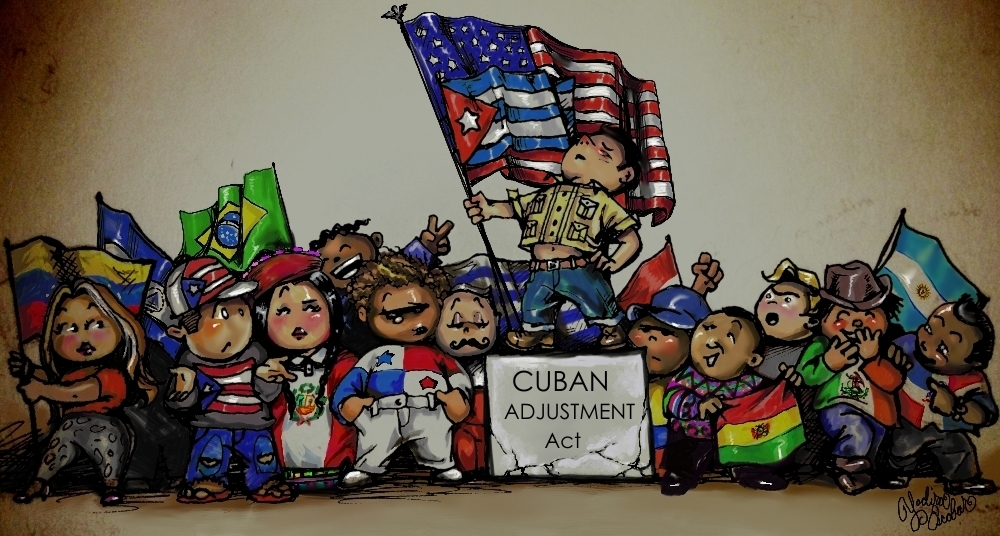
Are Cubans Latino?
MIAMI – One of the handiest skills needed to survive a bureaucracy is the acute ability to fill out application forms. Some are annoyingly complicated, intrusive and abstruse, but the system of paperwork serves as the most rationale method of organizing our societies. With the U.S. population of 2013 officially at 317,281,000, it makes sense to efficiently classify it all with serious paperwork. Clean, professional filing really does work.
Whether it’s a job, college or medical application, the most probable and recurring topic among others will be your ethnicity or race. For many it’s an easy routine to either scratch “native American”, x-mark the “white”, dash or circle “black”. When asked to simply describe themselves, however, many Cubans living in the United States find the dreaded ordeal distressing.
I have witnessed that elitist dissociation of certain Cubans who bitterly complain when filling out documents in south Florida. The common complaint is that they should be able to classify themselves as “White” and not “Hispanic”. The standard U.S. census classifies people from the Middle East and even North Africa as “white”, but for some reason in south Florida (I’m assuming in other states as well) it is not uncommon to see two very distinct groups: “White (not Hispanic)” followed by “Hispanic”. This, of course is the source of the criticism.
Now, to be Hispanic means you have culturally or historically something to do with Spain. Let’s not forget that Spain, in its glory, was the fourth largest empire in history reining over 19.4 million Kilometers and leaving a mark on its colonies. Initially “Latin” was a race classification, like the terms “Slavic” or “Teutonic”, but nowadays the name has shifted into an ethnic category, nothing else.
Cuba is geographically Caribbean, but the classification of “Latin” still applies to its people. They share one specific nationality even if they are made up of different, ever-changing genetic cocktails. Unlike most Ibero-American countries, the Cuban census includes color of skin as does Brazil and Puerto Rico. Those reports indicate that 56% of the Cuban population is “white”, but Turkish, Chinese, Indian or Mexican descendants go in that category as well. The reality is that the whitest Cuban lineage has some sort of “non-white” ingredient in its DNA. So not only is it repugnantly cruel to sustain any trace of racial supremacist ideology in any context, but totally absurd in Cuba.
When the Hispanic community takes to the streets and knocks doors at the grassroots level to push for immigration reform in the United States, most radically-thinking Cubans look the other way and obsess about some photograph of Raúl Castro taken in the last century. When Latinos rally to end poverty, to raise the minimum wage, or to protect civil rights, they unconditionally side with the Federal government without discrimination. Any new movement that advocates for a few meager changes for the lower classes smells like communism to them.
Perhaps too many Cubans naively pride themselves over a few economic successes, both on the historical and personal level. This is one of the consequences of the “Cuban Adjustment Act,” which facilitates the entire migratory process. For many, entering the country, obtaining a green card, and ultimately becoming a citizen is as easy as pie. This empirical community has been deprived of the usual migratory procedure and is thus, generally speaking, unsympathetic towards the typical struggles of a Latino.
This “special” treatment not only distances Cubans from the rest of Latin American immigrants by not permitting similar, shared experiences, but it mistakenly gives them a false sense of superiority. It’s a feeling of individual accomplishment, without touching reality. This, in part, might start explaining why in the world Cubans are typically the only Latinos vehemently voting Republican… while still impoverished.
Though each one of us likes to flaunt his own flag during Hispanic Heritage month, here in the U.S., the surging Latino culture unites those different nationalities – in part, perhaps, as a defense mechanism or unconscious survival tactic. Only when you accept your roots can you authentically open your heart to the struggle of an entire continent. Then, tasting a Nicaraguan co-workers “Flor de Caña” rum or a Peruvian friend’s golden, “Inca Cola” will be an act of defiance. To my mind comes the old Chinese proverb: “Sticks in a bundle cannot be broken.”
I know a lot of Cubans have, without second thoughts, crossed over and reached out to a Colombian colleague in need, helped undocumented friends or supported Dominican rights. Sadly, I have tragically overheard offensive Cuban slang and witnessed bawdy boasting of brutal nicknaming.
Radically-thinking Cubans have placed their trust on a few, traditional politicians in Congress, but the beautiful thing about Democracy is that it responds only to votes, not favoritism. It is predicted that in the future Latino voters will be proclaimed the majority in this great Federation, and my guess is… the tables will turn.
(Incidentally, has Miami Art Week left you craving more splashes of pop color and sculpted steel? The Smithsonian American Art Museum is currently exhibiting a modern collection of artworks created by 72 Hispanic artists since the 1950’s. The shows curators have titled it “Our America: The Latino Presence in American Art”, and it demonstrates that Dominican, Mexican and Cuban artists share an obvious heritage. Seems like another fine contribution to unity.)
A future heartfelt gesture of solidarity in whatever form by no means contradicts our Cuban patriotism or interferes with an American citizen’s ideal conduct or civil responsibilities. It’s a living manifestation of human altruism, conscience and mature solidarity.


